An Analysis of Perception, Bias, and Decision Making in Leadership
VerifiedAdded on 2022/09/22
|10
|2801
|30
Essay
AI Summary
This essay delves into the critical intersection of perception, bias, and decision-making, particularly within organizational contexts. It begins by examining the internal and external factors that shape individual perceptions, including needs, desires, personality, experience, size, intensity, frequency, and status. The essay then analyzes various cognitive biases, statistical biases, and prejudices that can cloud judgment and lead to suboptimal decisions. It highlights the organizational risks associated with poor decision-making, such as reduced credibility and a negative work environment, and explores how deadlines, resource constraints, and overconfidence exacerbate these challenges. The essay further discusses specific biases like anchoring, confirmation bias, patternicity, and the halo/horn effect, as well as prejudices related to gender, class, and race. Finally, the essay offers recommendations for mitigating bias in organizations, including implementing bias tests, reassessing decisions, establishing clear policies and guidelines, promoting reasoning and justification, and creating a robust decision-making framework based on research, information gathering, and continuous monitoring. The conclusion emphasizes the importance of awareness and vigilance in leadership to ensure logical, knowledge-driven decision-making.
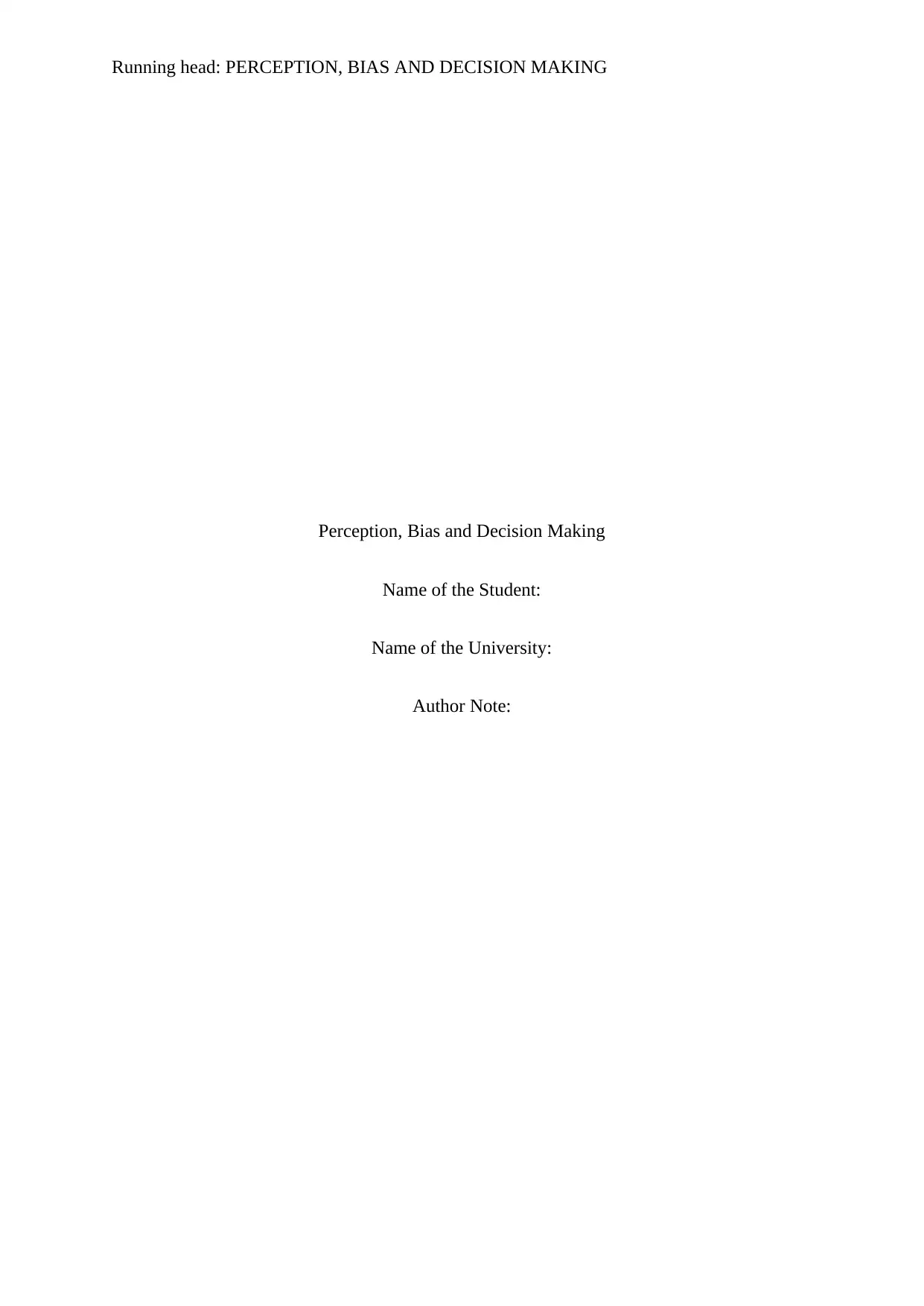
Running head: PERCEPTION, BIAS AND DECISION MAKING
Perception, Bias and Decision Making
Name of the Student:
Name of the University:
Author Note:
Perception, Bias and Decision Making
Name of the Student:
Name of the University:
Author Note:
Paraphrase This Document
Need a fresh take? Get an instant paraphrase of this document with our AI Paraphraser
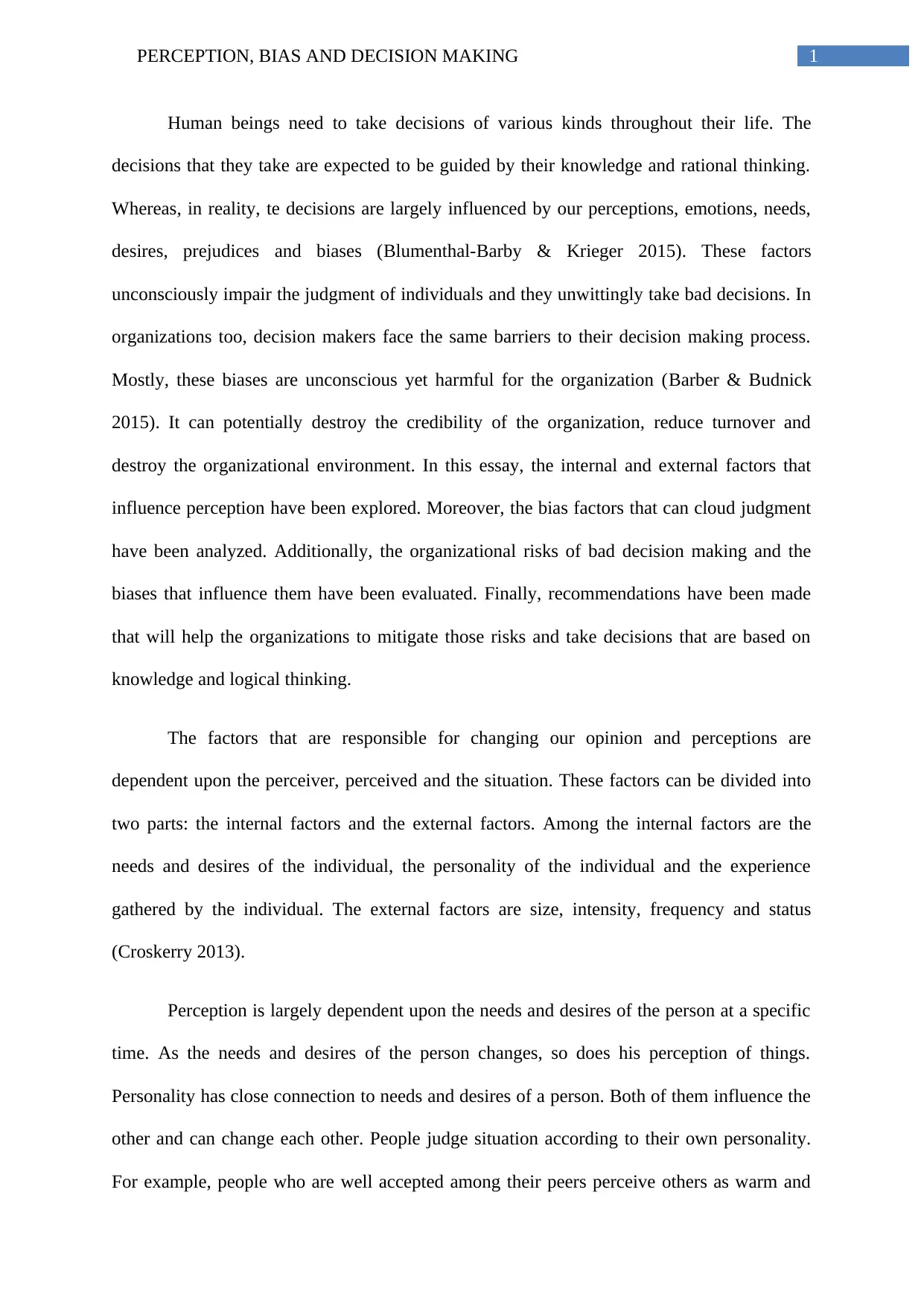
1PERCEPTION, BIAS AND DECISION MAKING
Human beings need to take decisions of various kinds throughout their life. The
decisions that they take are expected to be guided by their knowledge and rational thinking.
Whereas, in reality, te decisions are largely influenced by our perceptions, emotions, needs,
desires, prejudices and biases (Blumenthal-Barby & Krieger 2015). These factors
unconsciously impair the judgment of individuals and they unwittingly take bad decisions. In
organizations too, decision makers face the same barriers to their decision making process.
Mostly, these biases are unconscious yet harmful for the organization (Barber & Budnick
2015). It can potentially destroy the credibility of the organization, reduce turnover and
destroy the organizational environment. In this essay, the internal and external factors that
influence perception have been explored. Moreover, the bias factors that can cloud judgment
have been analyzed. Additionally, the organizational risks of bad decision making and the
biases that influence them have been evaluated. Finally, recommendations have been made
that will help the organizations to mitigate those risks and take decisions that are based on
knowledge and logical thinking.
The factors that are responsible for changing our opinion and perceptions are
dependent upon the perceiver, perceived and the situation. These factors can be divided into
two parts: the internal factors and the external factors. Among the internal factors are the
needs and desires of the individual, the personality of the individual and the experience
gathered by the individual. The external factors are size, intensity, frequency and status
(Croskerry 2013).
Perception is largely dependent upon the needs and desires of the person at a specific
time. As the needs and desires of the person changes, so does his perception of things.
Personality has close connection to needs and desires of a person. Both of them influence the
other and can change each other. People judge situation according to their own personality.
For example, people who are well accepted among their peers perceive others as warm and
Human beings need to take decisions of various kinds throughout their life. The
decisions that they take are expected to be guided by their knowledge and rational thinking.
Whereas, in reality, te decisions are largely influenced by our perceptions, emotions, needs,
desires, prejudices and biases (Blumenthal-Barby & Krieger 2015). These factors
unconsciously impair the judgment of individuals and they unwittingly take bad decisions. In
organizations too, decision makers face the same barriers to their decision making process.
Mostly, these biases are unconscious yet harmful for the organization (Barber & Budnick
2015). It can potentially destroy the credibility of the organization, reduce turnover and
destroy the organizational environment. In this essay, the internal and external factors that
influence perception have been explored. Moreover, the bias factors that can cloud judgment
have been analyzed. Additionally, the organizational risks of bad decision making and the
biases that influence them have been evaluated. Finally, recommendations have been made
that will help the organizations to mitigate those risks and take decisions that are based on
knowledge and logical thinking.
The factors that are responsible for changing our opinion and perceptions are
dependent upon the perceiver, perceived and the situation. These factors can be divided into
two parts: the internal factors and the external factors. Among the internal factors are the
needs and desires of the individual, the personality of the individual and the experience
gathered by the individual. The external factors are size, intensity, frequency and status
(Croskerry 2013).
Perception is largely dependent upon the needs and desires of the person at a specific
time. As the needs and desires of the person changes, so does his perception of things.
Personality has close connection to needs and desires of a person. Both of them influence the
other and can change each other. People judge situation according to their own personality.
For example, people who are well accepted among their peers perceive others as warm and
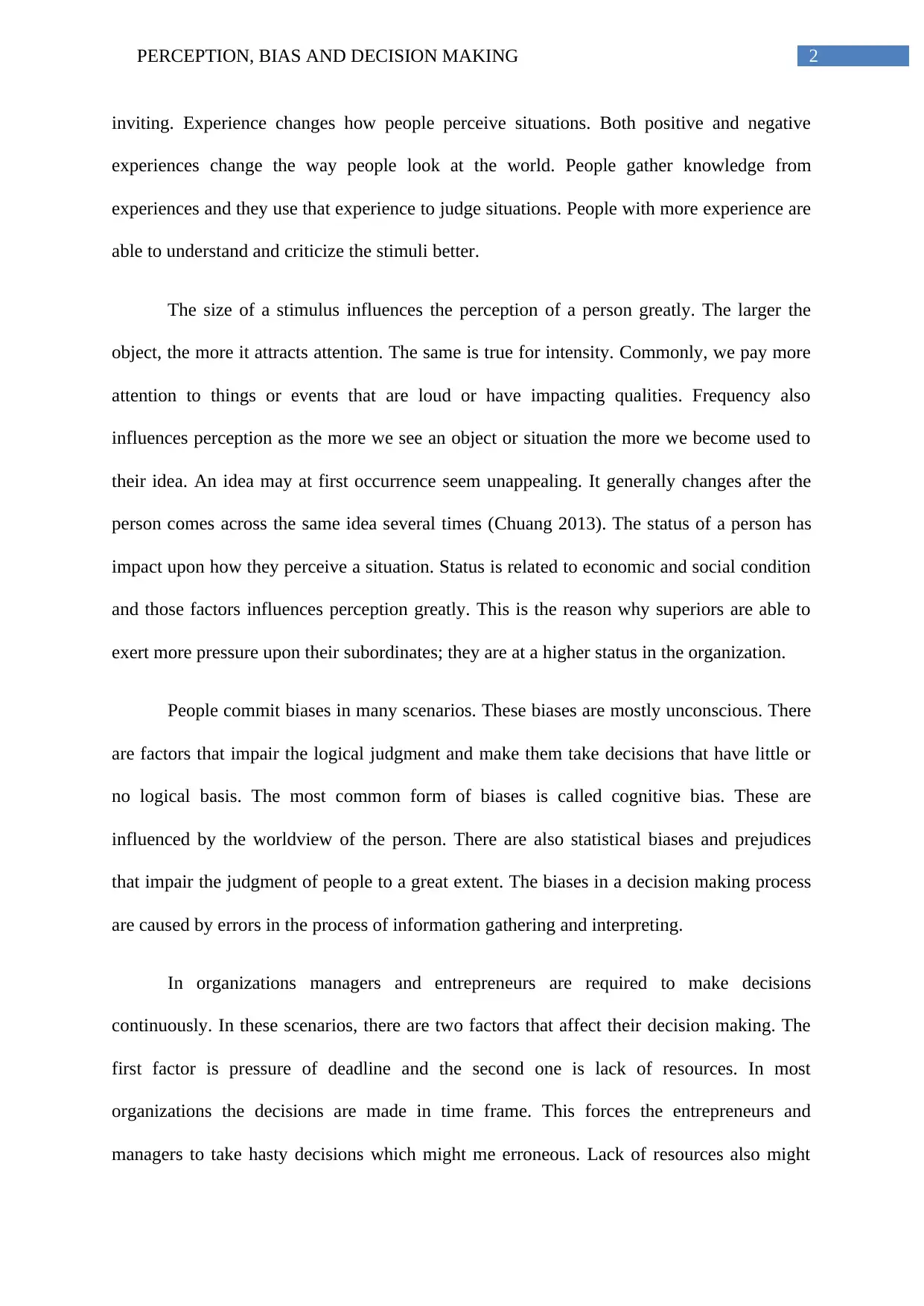
2PERCEPTION, BIAS AND DECISION MAKING
inviting. Experience changes how people perceive situations. Both positive and negative
experiences change the way people look at the world. People gather knowledge from
experiences and they use that experience to judge situations. People with more experience are
able to understand and criticize the stimuli better.
The size of a stimulus influences the perception of a person greatly. The larger the
object, the more it attracts attention. The same is true for intensity. Commonly, we pay more
attention to things or events that are loud or have impacting qualities. Frequency also
influences perception as the more we see an object or situation the more we become used to
their idea. An idea may at first occurrence seem unappealing. It generally changes after the
person comes across the same idea several times (Chuang 2013). The status of a person has
impact upon how they perceive a situation. Status is related to economic and social condition
and those factors influences perception greatly. This is the reason why superiors are able to
exert more pressure upon their subordinates; they are at a higher status in the organization.
People commit biases in many scenarios. These biases are mostly unconscious. There
are factors that impair the logical judgment and make them take decisions that have little or
no logical basis. The most common form of biases is called cognitive bias. These are
influenced by the worldview of the person. There are also statistical biases and prejudices
that impair the judgment of people to a great extent. The biases in a decision making process
are caused by errors in the process of information gathering and interpreting.
In organizations managers and entrepreneurs are required to make decisions
continuously. In these scenarios, there are two factors that affect their decision making. The
first factor is pressure of deadline and the second one is lack of resources. In most
organizations the decisions are made in time frame. This forces the entrepreneurs and
managers to take hasty decisions which might me erroneous. Lack of resources also might
inviting. Experience changes how people perceive situations. Both positive and negative
experiences change the way people look at the world. People gather knowledge from
experiences and they use that experience to judge situations. People with more experience are
able to understand and criticize the stimuli better.
The size of a stimulus influences the perception of a person greatly. The larger the
object, the more it attracts attention. The same is true for intensity. Commonly, we pay more
attention to things or events that are loud or have impacting qualities. Frequency also
influences perception as the more we see an object or situation the more we become used to
their idea. An idea may at first occurrence seem unappealing. It generally changes after the
person comes across the same idea several times (Chuang 2013). The status of a person has
impact upon how they perceive a situation. Status is related to economic and social condition
and those factors influences perception greatly. This is the reason why superiors are able to
exert more pressure upon their subordinates; they are at a higher status in the organization.
People commit biases in many scenarios. These biases are mostly unconscious. There
are factors that impair the logical judgment and make them take decisions that have little or
no logical basis. The most common form of biases is called cognitive bias. These are
influenced by the worldview of the person. There are also statistical biases and prejudices
that impair the judgment of people to a great extent. The biases in a decision making process
are caused by errors in the process of information gathering and interpreting.
In organizations managers and entrepreneurs are required to make decisions
continuously. In these scenarios, there are two factors that affect their decision making. The
first factor is pressure of deadline and the second one is lack of resources. In most
organizations the decisions are made in time frame. This forces the entrepreneurs and
managers to take hasty decisions which might me erroneous. Lack of resources also might
⊘ This is a preview!⊘
Do you want full access?
Subscribe today to unlock all pages.

Trusted by 1+ million students worldwide
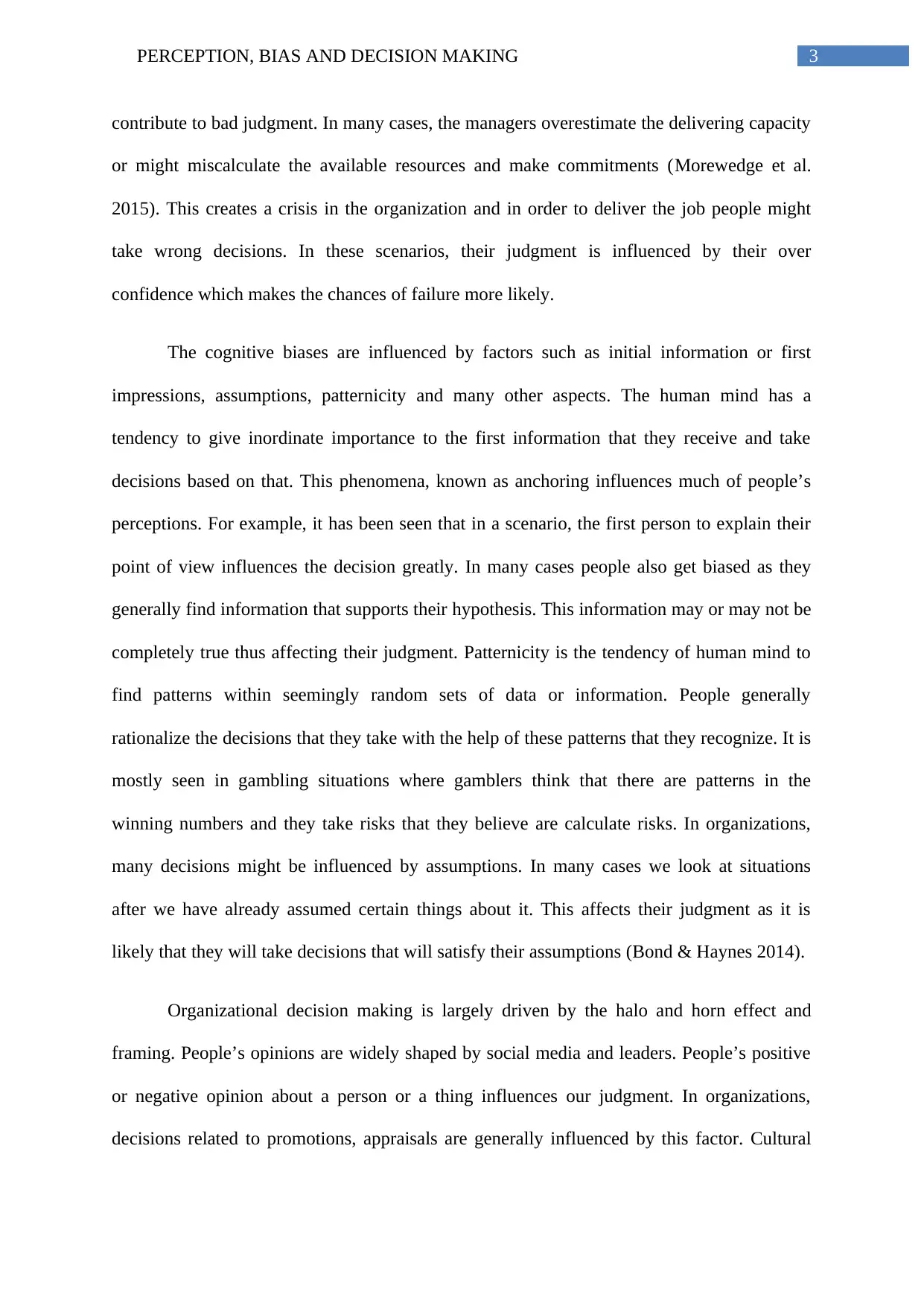
3PERCEPTION, BIAS AND DECISION MAKING
contribute to bad judgment. In many cases, the managers overestimate the delivering capacity
or might miscalculate the available resources and make commitments (Morewedge et al.
2015). This creates a crisis in the organization and in order to deliver the job people might
take wrong decisions. In these scenarios, their judgment is influenced by their over
confidence which makes the chances of failure more likely.
The cognitive biases are influenced by factors such as initial information or first
impressions, assumptions, patternicity and many other aspects. The human mind has a
tendency to give inordinate importance to the first information that they receive and take
decisions based on that. This phenomena, known as anchoring influences much of people’s
perceptions. For example, it has been seen that in a scenario, the first person to explain their
point of view influences the decision greatly. In many cases people also get biased as they
generally find information that supports their hypothesis. This information may or may not be
completely true thus affecting their judgment. Patternicity is the tendency of human mind to
find patterns within seemingly random sets of data or information. People generally
rationalize the decisions that they take with the help of these patterns that they recognize. It is
mostly seen in gambling situations where gamblers think that there are patterns in the
winning numbers and they take risks that they believe are calculate risks. In organizations,
many decisions might be influenced by assumptions. In many cases we look at situations
after we have already assumed certain things about it. This affects their judgment as it is
likely that they will take decisions that will satisfy their assumptions (Bond & Haynes 2014).
Organizational decision making is largely driven by the halo and horn effect and
framing. People’s opinions are widely shaped by social media and leaders. People’s positive
or negative opinion about a person or a thing influences our judgment. In organizations,
decisions related to promotions, appraisals are generally influenced by this factor. Cultural
contribute to bad judgment. In many cases, the managers overestimate the delivering capacity
or might miscalculate the available resources and make commitments (Morewedge et al.
2015). This creates a crisis in the organization and in order to deliver the job people might
take wrong decisions. In these scenarios, their judgment is influenced by their over
confidence which makes the chances of failure more likely.
The cognitive biases are influenced by factors such as initial information or first
impressions, assumptions, patternicity and many other aspects. The human mind has a
tendency to give inordinate importance to the first information that they receive and take
decisions based on that. This phenomena, known as anchoring influences much of people’s
perceptions. For example, it has been seen that in a scenario, the first person to explain their
point of view influences the decision greatly. In many cases people also get biased as they
generally find information that supports their hypothesis. This information may or may not be
completely true thus affecting their judgment. Patternicity is the tendency of human mind to
find patterns within seemingly random sets of data or information. People generally
rationalize the decisions that they take with the help of these patterns that they recognize. It is
mostly seen in gambling situations where gamblers think that there are patterns in the
winning numbers and they take risks that they believe are calculate risks. In organizations,
many decisions might be influenced by assumptions. In many cases we look at situations
after we have already assumed certain things about it. This affects their judgment as it is
likely that they will take decisions that will satisfy their assumptions (Bond & Haynes 2014).
Organizational decision making is largely driven by the halo and horn effect and
framing. People’s opinions are widely shaped by social media and leaders. People’s positive
or negative opinion about a person or a thing influences our judgment. In organizations,
decisions related to promotions, appraisals are generally influenced by this factor. Cultural
Paraphrase This Document
Need a fresh take? Get an instant paraphrase of this document with our AI Paraphraser
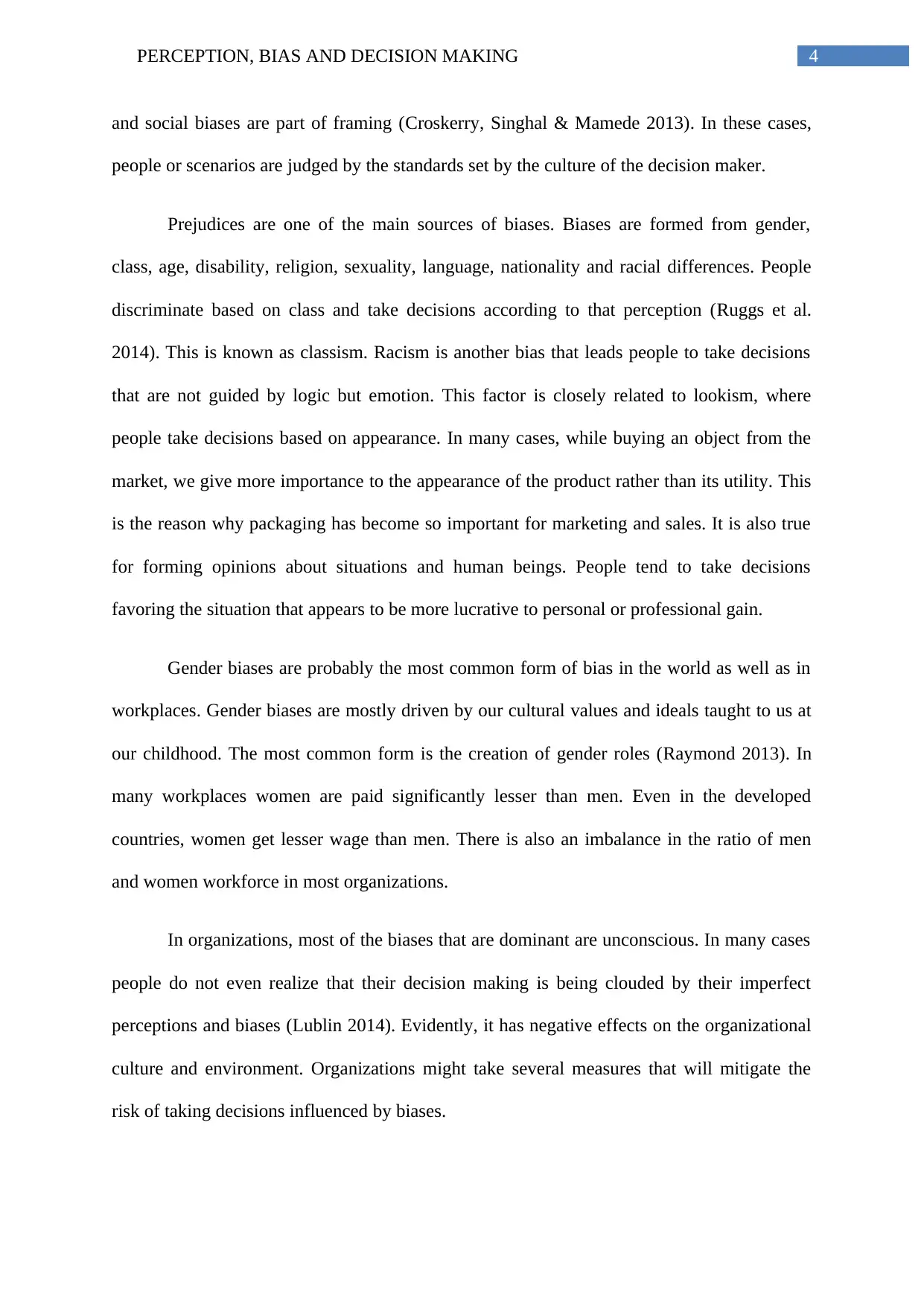
4PERCEPTION, BIAS AND DECISION MAKING
and social biases are part of framing (Croskerry, Singhal & Mamede 2013). In these cases,
people or scenarios are judged by the standards set by the culture of the decision maker.
Prejudices are one of the main sources of biases. Biases are formed from gender,
class, age, disability, religion, sexuality, language, nationality and racial differences. People
discriminate based on class and take decisions according to that perception (Ruggs et al.
2014). This is known as classism. Racism is another bias that leads people to take decisions
that are not guided by logic but emotion. This factor is closely related to lookism, where
people take decisions based on appearance. In many cases, while buying an object from the
market, we give more importance to the appearance of the product rather than its utility. This
is the reason why packaging has become so important for marketing and sales. It is also true
for forming opinions about situations and human beings. People tend to take decisions
favoring the situation that appears to be more lucrative to personal or professional gain.
Gender biases are probably the most common form of bias in the world as well as in
workplaces. Gender biases are mostly driven by our cultural values and ideals taught to us at
our childhood. The most common form is the creation of gender roles (Raymond 2013). In
many workplaces women are paid significantly lesser than men. Even in the developed
countries, women get lesser wage than men. There is also an imbalance in the ratio of men
and women workforce in most organizations.
In organizations, most of the biases that are dominant are unconscious. In many cases
people do not even realize that their decision making is being clouded by their imperfect
perceptions and biases (Lublin 2014). Evidently, it has negative effects on the organizational
culture and environment. Organizations might take several measures that will mitigate the
risk of taking decisions influenced by biases.
and social biases are part of framing (Croskerry, Singhal & Mamede 2013). In these cases,
people or scenarios are judged by the standards set by the culture of the decision maker.
Prejudices are one of the main sources of biases. Biases are formed from gender,
class, age, disability, religion, sexuality, language, nationality and racial differences. People
discriminate based on class and take decisions according to that perception (Ruggs et al.
2014). This is known as classism. Racism is another bias that leads people to take decisions
that are not guided by logic but emotion. This factor is closely related to lookism, where
people take decisions based on appearance. In many cases, while buying an object from the
market, we give more importance to the appearance of the product rather than its utility. This
is the reason why packaging has become so important for marketing and sales. It is also true
for forming opinions about situations and human beings. People tend to take decisions
favoring the situation that appears to be more lucrative to personal or professional gain.
Gender biases are probably the most common form of bias in the world as well as in
workplaces. Gender biases are mostly driven by our cultural values and ideals taught to us at
our childhood. The most common form is the creation of gender roles (Raymond 2013). In
many workplaces women are paid significantly lesser than men. Even in the developed
countries, women get lesser wage than men. There is also an imbalance in the ratio of men
and women workforce in most organizations.
In organizations, most of the biases that are dominant are unconscious. In many cases
people do not even realize that their decision making is being clouded by their imperfect
perceptions and biases (Lublin 2014). Evidently, it has negative effects on the organizational
culture and environment. Organizations might take several measures that will mitigate the
risk of taking decisions influenced by biases.
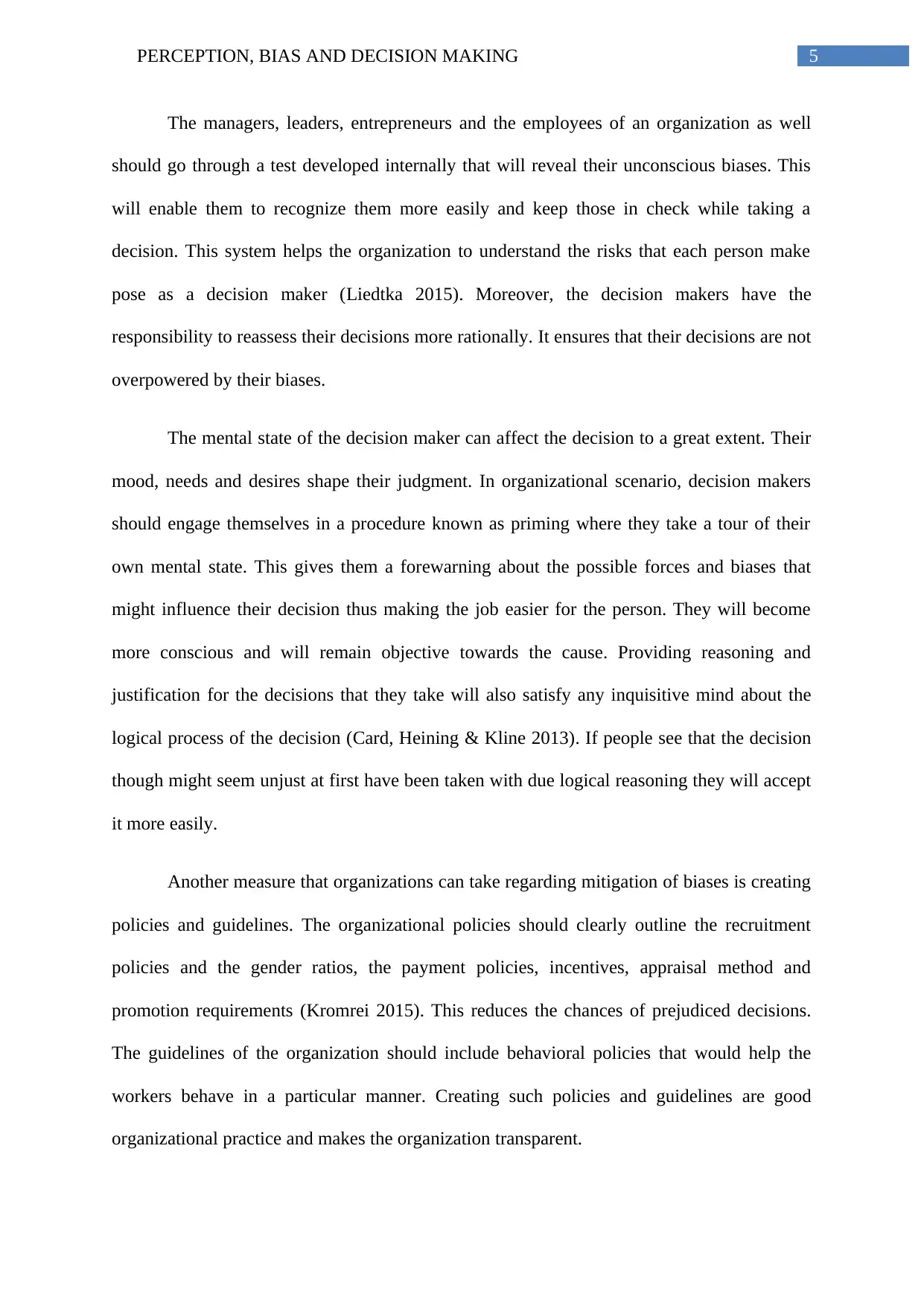
5PERCEPTION, BIAS AND DECISION MAKING
The managers, leaders, entrepreneurs and the employees of an organization as well
should go through a test developed internally that will reveal their unconscious biases. This
will enable them to recognize them more easily and keep those in check while taking a
decision. This system helps the organization to understand the risks that each person make
pose as a decision maker (Liedtka 2015). Moreover, the decision makers have the
responsibility to reassess their decisions more rationally. It ensures that their decisions are not
overpowered by their biases.
The mental state of the decision maker can affect the decision to a great extent. Their
mood, needs and desires shape their judgment. In organizational scenario, decision makers
should engage themselves in a procedure known as priming where they take a tour of their
own mental state. This gives them a forewarning about the possible forces and biases that
might influence their decision thus making the job easier for the person. They will become
more conscious and will remain objective towards the cause. Providing reasoning and
justification for the decisions that they take will also satisfy any inquisitive mind about the
logical process of the decision (Card, Heining & Kline 2013). If people see that the decision
though might seem unjust at first have been taken with due logical reasoning they will accept
it more easily.
Another measure that organizations can take regarding mitigation of biases is creating
policies and guidelines. The organizational policies should clearly outline the recruitment
policies and the gender ratios, the payment policies, incentives, appraisal method and
promotion requirements (Kromrei 2015). This reduces the chances of prejudiced decisions.
The guidelines of the organization should include behavioral policies that would help the
workers behave in a particular manner. Creating such policies and guidelines are good
organizational practice and makes the organization transparent.
The managers, leaders, entrepreneurs and the employees of an organization as well
should go through a test developed internally that will reveal their unconscious biases. This
will enable them to recognize them more easily and keep those in check while taking a
decision. This system helps the organization to understand the risks that each person make
pose as a decision maker (Liedtka 2015). Moreover, the decision makers have the
responsibility to reassess their decisions more rationally. It ensures that their decisions are not
overpowered by their biases.
The mental state of the decision maker can affect the decision to a great extent. Their
mood, needs and desires shape their judgment. In organizational scenario, decision makers
should engage themselves in a procedure known as priming where they take a tour of their
own mental state. This gives them a forewarning about the possible forces and biases that
might influence their decision thus making the job easier for the person. They will become
more conscious and will remain objective towards the cause. Providing reasoning and
justification for the decisions that they take will also satisfy any inquisitive mind about the
logical process of the decision (Card, Heining & Kline 2013). If people see that the decision
though might seem unjust at first have been taken with due logical reasoning they will accept
it more easily.
Another measure that organizations can take regarding mitigation of biases is creating
policies and guidelines. The organizational policies should clearly outline the recruitment
policies and the gender ratios, the payment policies, incentives, appraisal method and
promotion requirements (Kromrei 2015). This reduces the chances of prejudiced decisions.
The guidelines of the organization should include behavioral policies that would help the
workers behave in a particular manner. Creating such policies and guidelines are good
organizational practice and makes the organization transparent.
⊘ This is a preview!⊘
Do you want full access?
Subscribe today to unlock all pages.

Trusted by 1+ million students worldwide
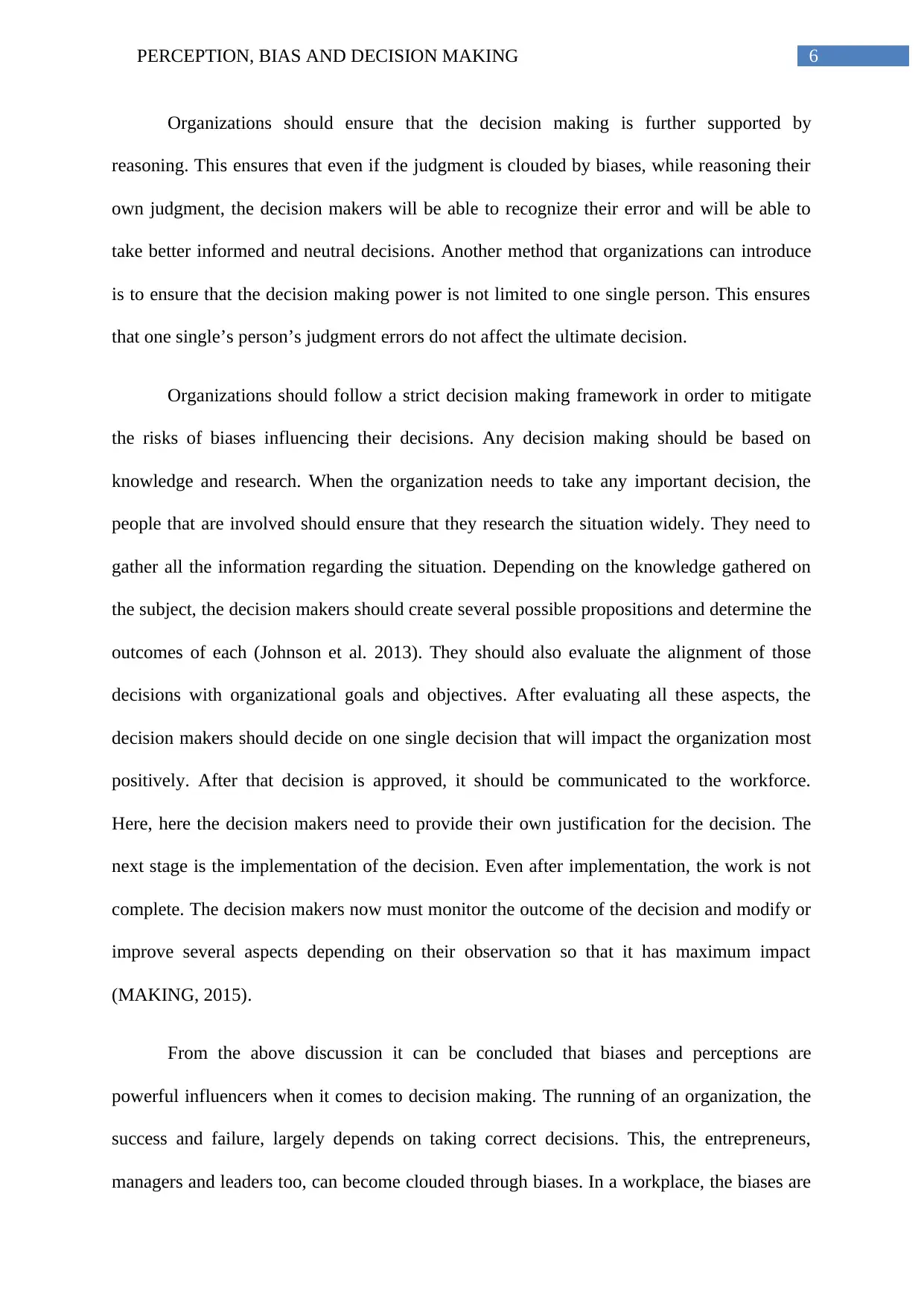
6PERCEPTION, BIAS AND DECISION MAKING
Organizations should ensure that the decision making is further supported by
reasoning. This ensures that even if the judgment is clouded by biases, while reasoning their
own judgment, the decision makers will be able to recognize their error and will be able to
take better informed and neutral decisions. Another method that organizations can introduce
is to ensure that the decision making power is not limited to one single person. This ensures
that one single’s person’s judgment errors do not affect the ultimate decision.
Organizations should follow a strict decision making framework in order to mitigate
the risks of biases influencing their decisions. Any decision making should be based on
knowledge and research. When the organization needs to take any important decision, the
people that are involved should ensure that they research the situation widely. They need to
gather all the information regarding the situation. Depending on the knowledge gathered on
the subject, the decision makers should create several possible propositions and determine the
outcomes of each (Johnson et al. 2013). They should also evaluate the alignment of those
decisions with organizational goals and objectives. After evaluating all these aspects, the
decision makers should decide on one single decision that will impact the organization most
positively. After that decision is approved, it should be communicated to the workforce.
Here, here the decision makers need to provide their own justification for the decision. The
next stage is the implementation of the decision. Even after implementation, the work is not
complete. The decision makers now must monitor the outcome of the decision and modify or
improve several aspects depending on their observation so that it has maximum impact
(MAKING, 2015).
From the above discussion it can be concluded that biases and perceptions are
powerful influencers when it comes to decision making. The running of an organization, the
success and failure, largely depends on taking correct decisions. This, the entrepreneurs,
managers and leaders too, can become clouded through biases. In a workplace, the biases are
Organizations should ensure that the decision making is further supported by
reasoning. This ensures that even if the judgment is clouded by biases, while reasoning their
own judgment, the decision makers will be able to recognize their error and will be able to
take better informed and neutral decisions. Another method that organizations can introduce
is to ensure that the decision making power is not limited to one single person. This ensures
that one single’s person’s judgment errors do not affect the ultimate decision.
Organizations should follow a strict decision making framework in order to mitigate
the risks of biases influencing their decisions. Any decision making should be based on
knowledge and research. When the organization needs to take any important decision, the
people that are involved should ensure that they research the situation widely. They need to
gather all the information regarding the situation. Depending on the knowledge gathered on
the subject, the decision makers should create several possible propositions and determine the
outcomes of each (Johnson et al. 2013). They should also evaluate the alignment of those
decisions with organizational goals and objectives. After evaluating all these aspects, the
decision makers should decide on one single decision that will impact the organization most
positively. After that decision is approved, it should be communicated to the workforce.
Here, here the decision makers need to provide their own justification for the decision. The
next stage is the implementation of the decision. Even after implementation, the work is not
complete. The decision makers now must monitor the outcome of the decision and modify or
improve several aspects depending on their observation so that it has maximum impact
(MAKING, 2015).
From the above discussion it can be concluded that biases and perceptions are
powerful influencers when it comes to decision making. The running of an organization, the
success and failure, largely depends on taking correct decisions. This, the entrepreneurs,
managers and leaders too, can become clouded through biases. In a workplace, the biases are
Paraphrase This Document
Need a fresh take? Get an instant paraphrase of this document with our AI Paraphraser
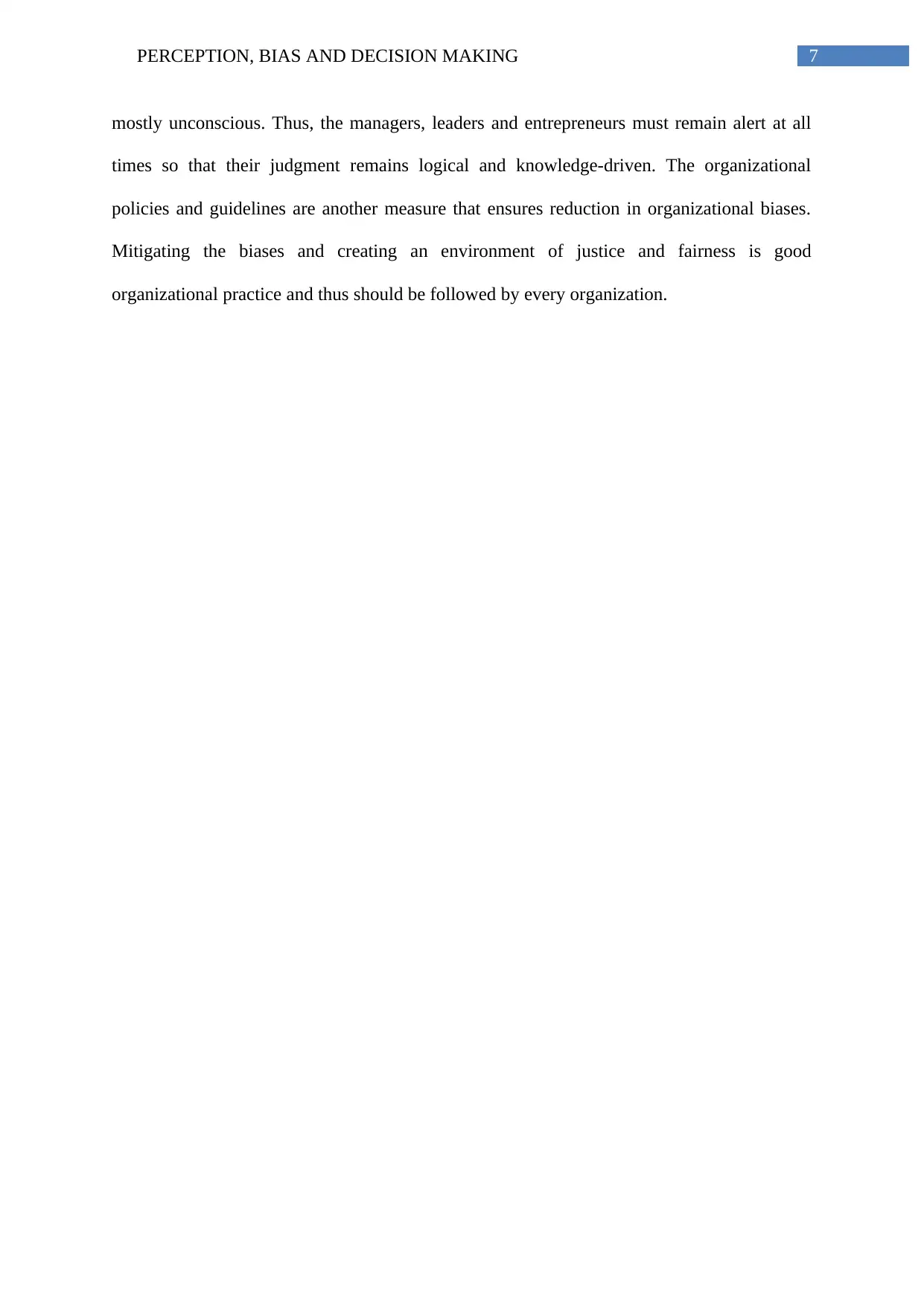
7PERCEPTION, BIAS AND DECISION MAKING
mostly unconscious. Thus, the managers, leaders and entrepreneurs must remain alert at all
times so that their judgment remains logical and knowledge-driven. The organizational
policies and guidelines are another measure that ensures reduction in organizational biases.
Mitigating the biases and creating an environment of justice and fairness is good
organizational practice and thus should be followed by every organization.
mostly unconscious. Thus, the managers, leaders and entrepreneurs must remain alert at all
times so that their judgment remains logical and knowledge-driven. The organizational
policies and guidelines are another measure that ensures reduction in organizational biases.
Mitigating the biases and creating an environment of justice and fairness is good
organizational practice and thus should be followed by every organization.
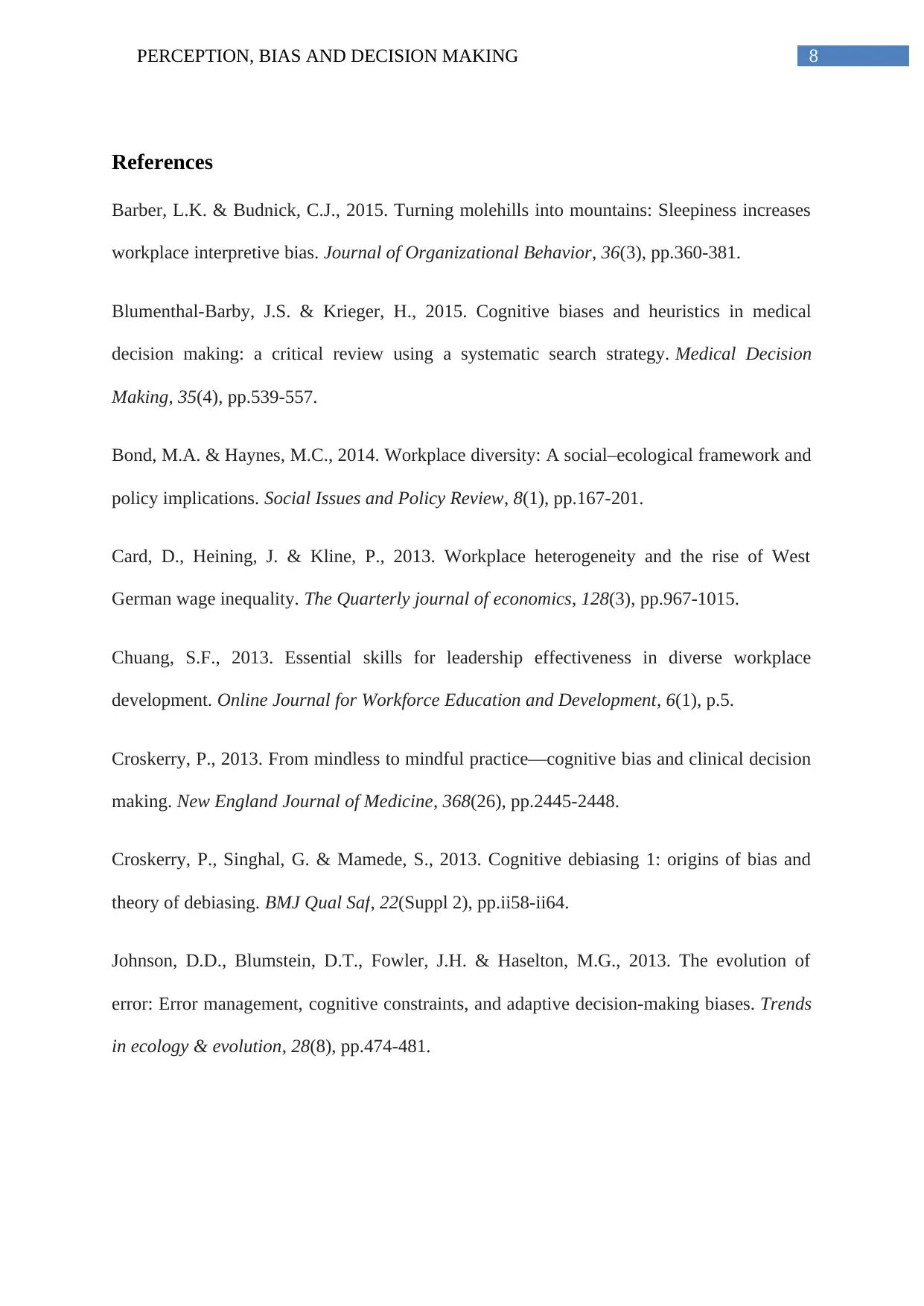
8PERCEPTION, BIAS AND DECISION MAKING
References
Barber, L.K. & Budnick, C.J., 2015. Turning molehills into mountains: Sleepiness increases
workplace interpretive bias. Journal of Organizational Behavior, 36(3), pp.360-381.
Blumenthal-Barby, J.S. & Krieger, H., 2015. Cognitive biases and heuristics in medical
decision making: a critical review using a systematic search strategy. Medical Decision
Making, 35(4), pp.539-557.
Bond, M.A. & Haynes, M.C., 2014. Workplace diversity: A social–ecological framework and
policy implications. Social Issues and Policy Review, 8(1), pp.167-201.
Card, D., Heining, J. & Kline, P., 2013. Workplace heterogeneity and the rise of West
German wage inequality. The Quarterly journal of economics, 128(3), pp.967-1015.
Chuang, S.F., 2013. Essential skills for leadership effectiveness in diverse workplace
development. Online Journal for Workforce Education and Development, 6(1), p.5.
Croskerry, P., 2013. From mindless to mindful practice—cognitive bias and clinical decision
making. New England Journal of Medicine, 368(26), pp.2445-2448.
Croskerry, P., Singhal, G. & Mamede, S., 2013. Cognitive debiasing 1: origins of bias and
theory of debiasing. BMJ Qual Saf, 22(Suppl 2), pp.ii58-ii64.
Johnson, D.D., Blumstein, D.T., Fowler, J.H. & Haselton, M.G., 2013. The evolution of
error: Error management, cognitive constraints, and adaptive decision-making biases. Trends
in ecology & evolution, 28(8), pp.474-481.
References
Barber, L.K. & Budnick, C.J., 2015. Turning molehills into mountains: Sleepiness increases
workplace interpretive bias. Journal of Organizational Behavior, 36(3), pp.360-381.
Blumenthal-Barby, J.S. & Krieger, H., 2015. Cognitive biases and heuristics in medical
decision making: a critical review using a systematic search strategy. Medical Decision
Making, 35(4), pp.539-557.
Bond, M.A. & Haynes, M.C., 2014. Workplace diversity: A social–ecological framework and
policy implications. Social Issues and Policy Review, 8(1), pp.167-201.
Card, D., Heining, J. & Kline, P., 2013. Workplace heterogeneity and the rise of West
German wage inequality. The Quarterly journal of economics, 128(3), pp.967-1015.
Chuang, S.F., 2013. Essential skills for leadership effectiveness in diverse workplace
development. Online Journal for Workforce Education and Development, 6(1), p.5.
Croskerry, P., 2013. From mindless to mindful practice—cognitive bias and clinical decision
making. New England Journal of Medicine, 368(26), pp.2445-2448.
Croskerry, P., Singhal, G. & Mamede, S., 2013. Cognitive debiasing 1: origins of bias and
theory of debiasing. BMJ Qual Saf, 22(Suppl 2), pp.ii58-ii64.
Johnson, D.D., Blumstein, D.T., Fowler, J.H. & Haselton, M.G., 2013. The evolution of
error: Error management, cognitive constraints, and adaptive decision-making biases. Trends
in ecology & evolution, 28(8), pp.474-481.
⊘ This is a preview!⊘
Do you want full access?
Subscribe today to unlock all pages.

Trusted by 1+ million students worldwide
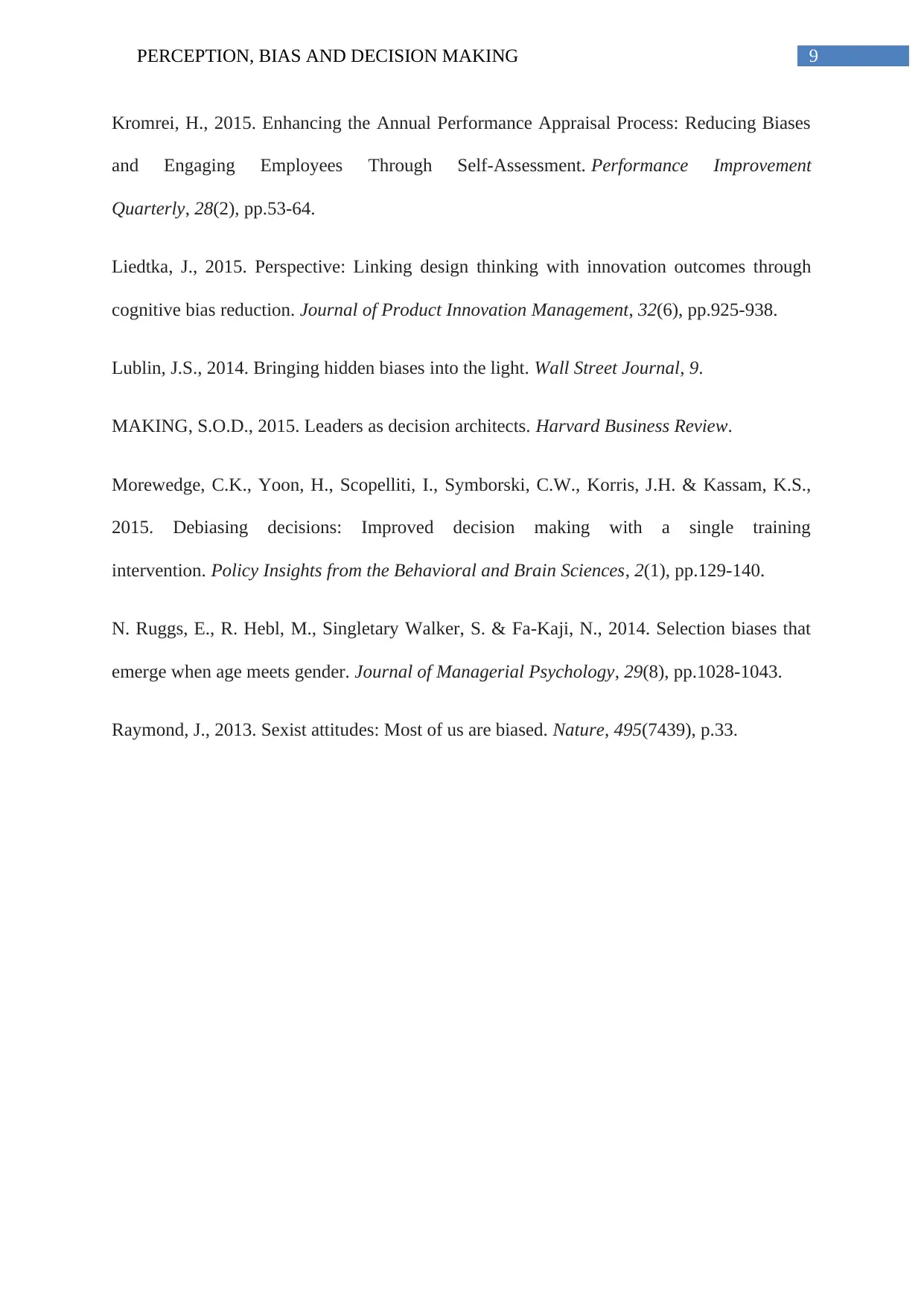
9PERCEPTION, BIAS AND DECISION MAKING
Kromrei, H., 2015. Enhancing the Annual Performance Appraisal Process: Reducing Biases
and Engaging Employees Through Self‐Assessment. Performance Improvement
Quarterly, 28(2), pp.53-64.
Liedtka, J., 2015. Perspective: Linking design thinking with innovation outcomes through
cognitive bias reduction. Journal of Product Innovation Management, 32(6), pp.925-938.
Lublin, J.S., 2014. Bringing hidden biases into the light. Wall Street Journal, 9.
MAKING, S.O.D., 2015. Leaders as decision architects. Harvard Business Review.
Morewedge, C.K., Yoon, H., Scopelliti, I., Symborski, C.W., Korris, J.H. & Kassam, K.S.,
2015. Debiasing decisions: Improved decision making with a single training
intervention. Policy Insights from the Behavioral and Brain Sciences, 2(1), pp.129-140.
N. Ruggs, E., R. Hebl, M., Singletary Walker, S. & Fa-Kaji, N., 2014. Selection biases that
emerge when age meets gender. Journal of Managerial Psychology, 29(8), pp.1028-1043.
Raymond, J., 2013. Sexist attitudes: Most of us are biased. Nature, 495(7439), p.33.
Kromrei, H., 2015. Enhancing the Annual Performance Appraisal Process: Reducing Biases
and Engaging Employees Through Self‐Assessment. Performance Improvement
Quarterly, 28(2), pp.53-64.
Liedtka, J., 2015. Perspective: Linking design thinking with innovation outcomes through
cognitive bias reduction. Journal of Product Innovation Management, 32(6), pp.925-938.
Lublin, J.S., 2014. Bringing hidden biases into the light. Wall Street Journal, 9.
MAKING, S.O.D., 2015. Leaders as decision architects. Harvard Business Review.
Morewedge, C.K., Yoon, H., Scopelliti, I., Symborski, C.W., Korris, J.H. & Kassam, K.S.,
2015. Debiasing decisions: Improved decision making with a single training
intervention. Policy Insights from the Behavioral and Brain Sciences, 2(1), pp.129-140.
N. Ruggs, E., R. Hebl, M., Singletary Walker, S. & Fa-Kaji, N., 2014. Selection biases that
emerge when age meets gender. Journal of Managerial Psychology, 29(8), pp.1028-1043.
Raymond, J., 2013. Sexist attitudes: Most of us are biased. Nature, 495(7439), p.33.
1 out of 10
Related Documents
Your All-in-One AI-Powered Toolkit for Academic Success.
+13062052269
info@desklib.com
Available 24*7 on WhatsApp / Email
![[object Object]](/_next/static/media/star-bottom.7253800d.svg)
Unlock your academic potential
Copyright © 2020–2025 A2Z Services. All Rights Reserved. Developed and managed by ZUCOL.





